
The Florida Keys National Marine Sanctuary is a U.S. National Marine Sanctuary in the Florida Keys. It includes the Florida Reef, the only barrier coral reef in North America and the third-largest coral barrier reef in the world. It also has extensive mangrove forest and seagrass fields. The Florida Keys National Marine Sanctuary, designated in 1990, is the ninth national marine sanctuary to be established in a system that comprises 13 sanctuaries and two marine national monuments. The Florida Keys National Marine Sanctuary protects approximately 2,900 square nautical miles of coastal and ocean waters from the estuarine waters of south Florida along the Florida Keys archipelago, encompassing more than 1,700 islands, out to the Dry Tortugas National Park, reaching into the Atlantic Ocean, Florida Bay and the Gulf of Mexico.

Caulerpa taxifolia is a species of green seaweed, an alga of the genus Caulerpa, native to tropical waters of the Pacific Ocean, Indian Ocean, and Caribbean Sea. The species name taxifolia arises from the resemblance of its leaf-like fronds to those of the yew (Taxus).
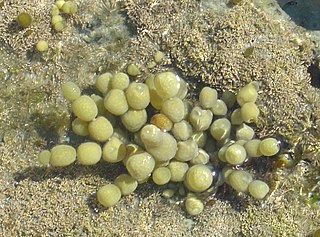
Hormosira is a genus of seaweed in the family Hormosiraceae. It is monotypic, with a single species, Hormosira banksii, also known as Neptune's necklace, Neptune's pearls, sea grapes, or bubbleweed it is native to Australia and New Zealand.
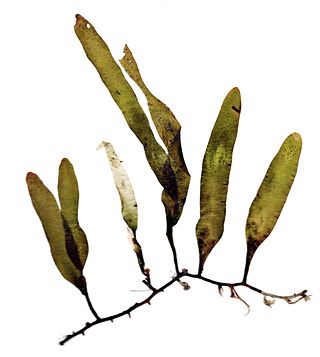
Caulerpa is a genus of seaweeds in the family Caulerpaceae. They are unusual because they consist of only one cell with many nuclei, making them among the biggest single cells in the world.

Caulerpa racemosa is a species of edible green alga, a seaweed in the family Caulerpaceae. It is commonly known as sea grapes and is found in many areas of shallow sea around the world. Despite the name, it is not related to grapes. There are a number of different forms and varieties, and one that appeared in the Mediterranean Sea in 1990, which is giving cause for concern as an invasive species.

The alligator pipefish or double-ended pipefish is a species of fish in the family Syngnathidae and is the only species in the monotypic genus Syngnathoides. It is found in shallow water in the tropical and subtropical Indo-Pacific, its range extending from East Africa to northern Australia. This fish lives in habitats of seagrass and seaweed, and hides by positioning itself vertically with its head down amidst the similar-coloured fronds of vegetation. The elongated, well-camouflaged body can reach 29 cm (11 in) in length. It feeds by sucking up its prey.

Limu, otherwise known as rimu, remu or ʻimu is a general Polynesian term for edible plants living underwater, such as seaweed, or plants living near water, like algae. In Hawaii, there are approximately one hundred names for kinds of limu, sixty of which can be matched with scientific names. Hundreds of species of marine algae were once found in Hawaii. Many limu are edible, and used in the cuisine throughout most of Polynesia.
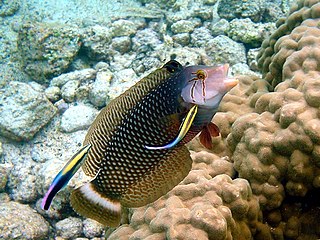
Novaculichthys taeniourus, also known as the rockmover wrasse, carpet wrasse, dragon wrasse, bar-cheeked wrasse, olive-scribbled wrasse or reindeer wrasse, is a species of wrasse mainly found in coral reefs and lagoons in the Indo-Pacific region. These include habitats in the Gulf of California to Panama; tropical Pacific Ocean islands including Hawaii; the Philippines, Indonesia and Australia; and the Indian Ocean to the east coast of Africa. The common name, "rockmover wrasse", comes from their behavior of upending small stones and reef fragments in search of prey. This species is the only known member of its genus.

Bunaken National Park is a marine park in the north of Sulawesi Island, Indonesia. The park is located near the centre of the Coral Triangle, providing habitat to 390 species of coral as well as many fish, mollusks, reptiles and marine mammal species. The park is representative of Indonesian tropical water ecosystems, consisting of seagrass plains, coral reefs and coastal ecosystems.

Halimeda tuna is a species of calcareous green seaweed in the order Bryopsidales. It is found on reefs in the Atlantic Ocean, the Indo-Pacific region and the Mediterranean Sea. Halimeda tuna is the type species of the genus Halimeda and the type locality is the Mediterranean Sea. The specific name "tuna" comes from the Taíno language, meaning "cactus" and referring to the resemblance of the thallus to the growth form of an Opuntia cactus.

Caulerpa prolifera is a species of green alga, a seaweed in the family Caulerpaceae. It is the type species of the genus Caulerpa, the type location being Alexandria, Egypt. It grows rapidly and forms a dense mass of vegetation on shallow sandy areas of the sea.

Calotomus carolinus, commonly known as Carolines parrotfish, is a species of marine ray-finned fish, a parrotfish, in the family Scaridae. It is also known as the starry-eye parrotfish, stareye parrotfish, bucktooth parrotfish, Christmas parrotfish or marbled parrotfish. Since the Calotomus carolinus is known across the Pacific, it also has its own name in many native languages for example, it is called a panuhunuhunu in the Hawaiian language.
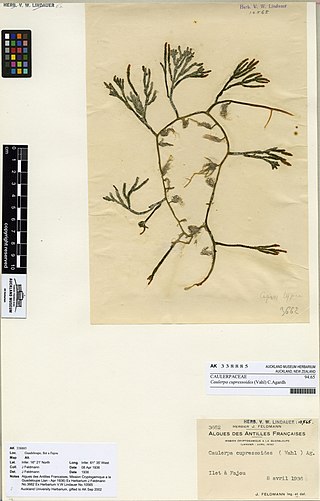
Caulerpa cupressoides, commonly known as cactus tree alga, is a species of seaweed in the Caulerpaceae family. Green alge of Caulerpa genus are salty and pungent in style and are consumed by several marine cultures around the world.

Caulerpa cylindracea is a species of seaweed in the Caulerpaceae family.

Caulerpa sedoides, also known as mini-grapes or bubble caulerpa, is a species of seaweed in the Caulerpaceae family native to Australia.

Caulerpa sertularioides, also known as green feather algae, is a species of seaweed in the Caulerpaceae family found in warm water environments.

Caulerpa webbiana, commonly known as bottlebrush green seaweed, is a species of seaweed in the family Caulerpaceae.
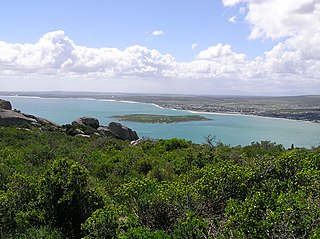
The Langebaan Lagoon Marine Protected Area is an inshore conservation region in the territorial waters of South Africa

The coral reefs of Tuvalu consist of three reef islands and six atolls, containing approximately 710 km2 (270 sq mi) of reef platforms. The islands of the Tuvalu archipelago are spread out between the latitude of 5° to 10° south and longitude of 176° to 180°, west of the International Date Line. The islands of Tuvalu are volcanic in origin. On the atolls, an annular reef rim surrounds the lagoon, and may include natural reef channels. The reef islands have a different structure to the atolls, and are described as reef platforms as they are smaller tabular reef platforms that do not have a salt-water lagoon, although they may have a completely closed rim of dry land, with the remnants of a lagoon that has no direct connection to the open sea or that may be drying up.




















